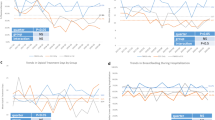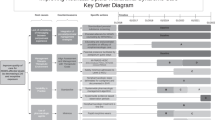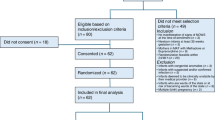Abstract
Objective
To support hospitals in the Massachusetts PNQIN collaborative with adoption of the ESC Neonatal Opioid Withdrawal Syndrome (NOWS) Care Tool© and assess NOWS hospitalization outcomes.
Study design
Statewide QI study where 11 hospitals adopted the ESC NOWS Care Tool©. Outcomes of pharmacotherapy and length of hospital stay (LOS) and were compared in Pre- and Post-ESC implementation cohorts. Statistical Process Control (SPC) charts were used to examine changes over time.
Results
The Post-ESC group had lower rates of pharmacotherapy (OR 0.35, 95% CI 0.26, 0.46) with shorter LOS (RR 0.79, 95% CI 0.76, 0.82). The 30-day NOWS readmission rate was 1.2% in the Pre- and 0.4% in the Post-ESC cohort. SPC charts indicate a shift in pharmacotherapy from 54.8 to 35.0% and LOS from 14.2 to 10.9 days Post-ESC.
Conclusions
The ESC NOWS Care Tool was successfully implemented across a state collaborative with improvement in NOWS outcomes without short-term adverse effects.
This is a preview of subscription content, access via your institution
Access options
Subscribe to this journal
Receive 12 print issues and online access
$259.00 per year
only $21.58 per issue
Buy this article
- Purchase on SpringerLink
- Instant access to full article PDF
Prices may be subject to local taxes which are calculated during checkout


Similar content being viewed by others
References
Winkelman TNA, Villapiano N, Kozhimannil KB, Davis MM, Patrick SW. Incidence and costs of neonatal abstinence syndrome among infants with medicaid: 2004–2014. Pediatrics 2018;141. https://doi.org/10.1542/peds.2017-3520.
Milliren CE, Gupta M, Graham DA, Melvin P, Jorina M, Ozonoff A. Hospital variation in neonatal abstinence syndrome incidence, treatment modalities, resource use, and costs across pediatric hospitals in the United States, 2013 to 2016. Hosp Pediatr. 2018;8:15–20.
Mehta A, Forbes KD, Kuppala VS. Neonatal abstinence syndrome management from prenatal counseling to postdischarge follow-up care: results of a national survey. Hosp Pediatr. 2013;3:317–23.
Tolia VN, Patrick SW, Bennett MM, Murthy K, Sousa J, Smith PB, et al. Increasing incidence of the neonatal abstinence syndrome in U.S. neonatal ICUs. N. Engl J Med. 2015;372:2118–26.
Patrick SW, Davis MM, Lehman CU, Cooper WO. Increasing incidence and geographic distribution of neonatal abstinence syndrome: United States 2009 to 2012. J Perinatol. 2015;35:667.
Bogen DL, Whalen BL, Kair LR, Vining M, King BA. Wide variation found in care of opioid-exposed newborns. Acad Pediatr. 2017;17:374–80.
Snowden JN, Akshatha A, Annett RD, Crawford MM, Das A, Devlin LA, et al. The ACT NOW clinical practice survey: gaps in the care of infants with neonatal opioid withdrawal syndrome. Hosp Pediatr. 2019;9:585–92.
Schiff DM, Grossman MR. Beyond the Finnegan scoring system: novel assessment and diagnostic techniques for the opioid-exposed infant. Semin Fetal Neonatal Med. 2019;24:115–20.
Finnegan LP, Connaughton JF Jr, Kron RE, Emich JP. Neonatal abstinence syndrome: assessment and management. Addict Dis. 1975;2:141–58.
Jones HE, Seashore C, Johnson E, Horton E, O’Grady KE, Andringa K, et al. Psychometric assessment of the Neonatal Abstinence Scoring System and the MOTHER NAS Scale. Am J Addict. 2016;25:370–3.
Grossman MR, Berkwitt AK, Osborn RR, Xu Y, Esserman DA, Shapiro ED, et al. An initiative to improve the quality of care of infants with neonatal abstinence syndrome. Pediatrics 2017;139. https://doi.org/10.1542/peds.2016-3360.
Grossman MR, Lipshaw MJ, Osborn RR, Berkwitt AK. A novel approach to assessing infants with neonatal abstinence syndrome. Hosp Pediatr. 2018;8:1–6.
Wachman EM, Grossman M, Schiff DM, Philipp BL, Minear S, Hutton E, et al. Quality improvement initiative to improve inpatient outcomes for neonatal abstinence syndrome. J Perinatol. 2018;38:1114–22.
Whalen BL, Grossman MR, Whatley C. Inter- and intra-rater reliability of the Eating, Sleeping, Consoling (ESC) Care Tool for Neonatal Abstinence Syndrome (NAS). In: Proceedings from the 2018 Annual Meeting of the Pediatric Academic Societies; May 5–8, 2018; Toronto, Canada.
Whalen BL, MacMillan KD, Flanagan VA, Picarillo A. NNEPQIN NAS initiative: implementation of the eat, sleep, console care tool across a regional neonatal quality improvement network. In: Proceedings from the 2019 Annual Meeting of the Pediatric Academic Societies; April 27–30, 2019; Baltimore, MD.
Achilles JS, Castaneda-Lovato J. A quality improvement initiative to improve the care of infants born exposed to opioids by implementing the eat, sleep, console assessment tool. Hosp Pediatr. 2019;9:624–31.
Blount T, Painter A, Freeman E, Grossman M, Sutton AG. Reduction in length of stay and morphine use for NAS with the “eat, sleep, console” method. Hosp Pediatr. 2019;9:615–23.
Parlaman J, Deodhar P, Sanders V, Jerome J, McDaniel C. Improving care for infants with neonatal abstinence syndrome: a multicenter, community hospital-based study. Hosp Pediatr. 2019;9:608–14.
Dodds D, Koch K, Buitrago-Mogollon T, Horstmann S. Successful implementation of the eat sleep console model of care for infants with NAS in a community hospital. Hosp Pediatr. 2019;9:632–8.
MacMillan KDL, Rendon CP, Verma K, Riblet N, Washer DB, Volpe Holmes A. Association of rooming-in with outcomes for neonatal abstinence syndrome: a systematic review and meta-analysis. JAMA Pediatr. 2018;172:345–51.
Wachman EM, Schiff DM, Silverstein M. Neonatal abstinence syndrome: advances in diagnosis and treatment. JAMA. 2018;319:1362–74.
Howard MB, Schiff DM, Penwill N, Si W, Rai A, Wolfgang T, et al. Impact of parental presence at infants’ bedside on neonatal abstinence syndrome. Hosp Pediatr. 2017;7:63–69.
Massachusetts Perinatal Neonatal Quality Improvement Network (PNQIN) Perinatal Opioid Project. http://www.pnqinma.org/perinatal-opioid-project. Accessed 16 March 2020.
Kilo CM. A framework for collaborative improvement: lessons from the Institute for Healthcare Improvement’s Breakthrough Series. Qual Manag Health Care. 1998;6:1–13.
Gupta M, Kaplan HC. Using statistical process control to drive improvement in neonatal care: a practical introduction to control charts. Clin Perinatol. 2017;44:627–44.
Baby Friendly USA. http://www.babyfriendlyusa.org. Accessed 16 March 2020.
Wachman EM, Warden AH, Thomas Z, Thomas-Lewis JA, Shrestha H, Nikita FNU, et al. Impact of psychiatric medication co-exposure on Neonatal Abstinence Syndrome severity. Drug Alcohol Depend. 2018;192:45–50.
Acknowledgements
We would like to acknowledge the Massachusetts PNQIN perinatal opioid project leadership team, the ESC leadership team, and ESC NOWS Care Tool creators (Bonny Whalen, Elisha Wachman, Kathryn MacMillan, Susan Minear, Matthew Grossman). We would like to thank the numerous people at each hospital who participated in the multi-disciplinary teams needed to implement the ESC NOWS Care Tool.
Funding
This study was supported by grant funding from the Massachusetts Health Policy Commission and the Massachusetts Department of Public Health (CDC Grant no. NU58DP006371).
Author information
Authors and Affiliations
Contributions
All authors reviewed and edited the manuscript, and approved the final submitted version. EMW wrote the first draft of the manuscript, developed the concept for the project and led the project; MG supervised the project, helped develop the concept, and provided key resources and data coordination; MH was a key project lead involved in site, conference, data collection coordination; PM performed the data analysis, table and figure creation; EMW, JM, SM, KDLM, and BLW created the ESC Care Tool training materials, led workshops and webinars, and provided site support; BCI wrote portions of the first draft of the manuscript and assisted with data collection; EMW, JM, RS, DB, AW, TM, RG, SJ, and DRG were site leads who supervised implementation and data collection at their hospitals; HD and FH provided overall project leadership and resources.
Corresponding author
Ethics declarations
Conflict of interest
The authors declare that they have no conflict of interest.
Additional information
Publisher’s note Springer Nature remains neutral with regard to jurisdictional claims in published maps and institutional affiliations.
Supplementary information
Rights and permissions
About this article
Cite this article
Wachman, E.M., Houghton, M., Melvin, P. et al. A quality improvement initiative to implement the eat, sleep, console neonatal opioid withdrawal syndrome care tool in Massachusetts’ PNQIN collaborative. J Perinatol 40, 1560–1569 (2020). https://doi.org/10.1038/s41372-020-0733-y
Received:
Revised:
Accepted:
Published:
Issue date:
DOI: https://doi.org/10.1038/s41372-020-0733-y
This article is cited by
-
Efficacy of stochastic vibro-tactile stimulation for newborns at risk of neonatal opioid withdrawal syndrome
Pediatric Research (2025)
-
Short term outcomes of neonatal opioid withdrawal syndrome: a comparison of two approaches
Journal of Perinatology (2024)
-
Association between pharmacologic treatment and hospital utilization at birth among neonatal opioid withdrawal syndrome mother-infant dyads
Journal of Perinatology (2023)
-
Neonatal opioid withdrawal syndrome: a review of the science and a look toward the use of buprenorphine for affected infants
Journal of Perinatology (2022)
-
Leveraging the Massachusetts perinatal quality collaborative to address the COVID-19 pandemic among diverse populations
Journal of Perinatology (2021)



